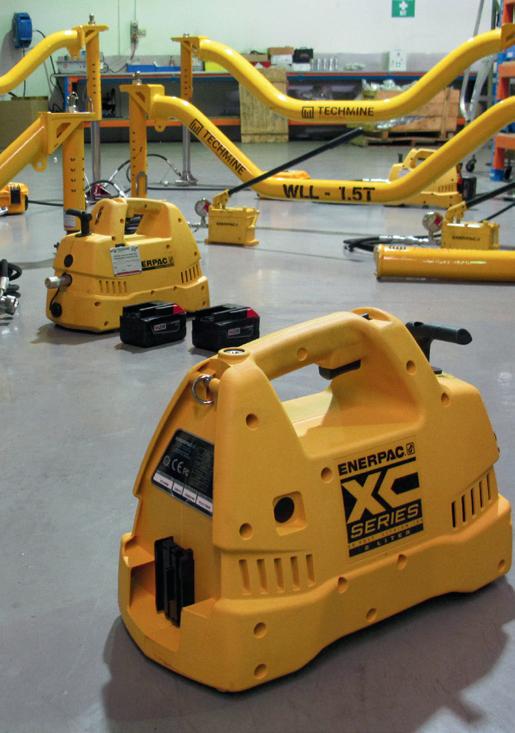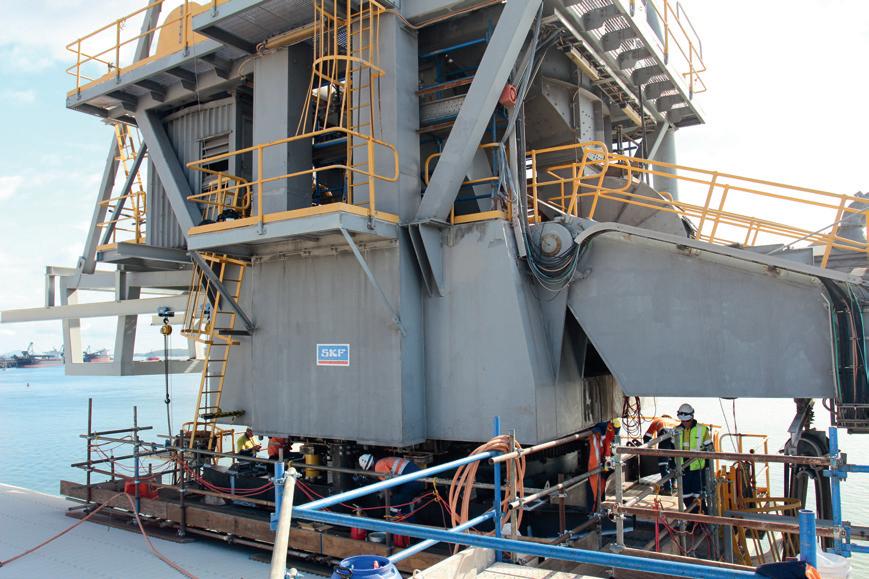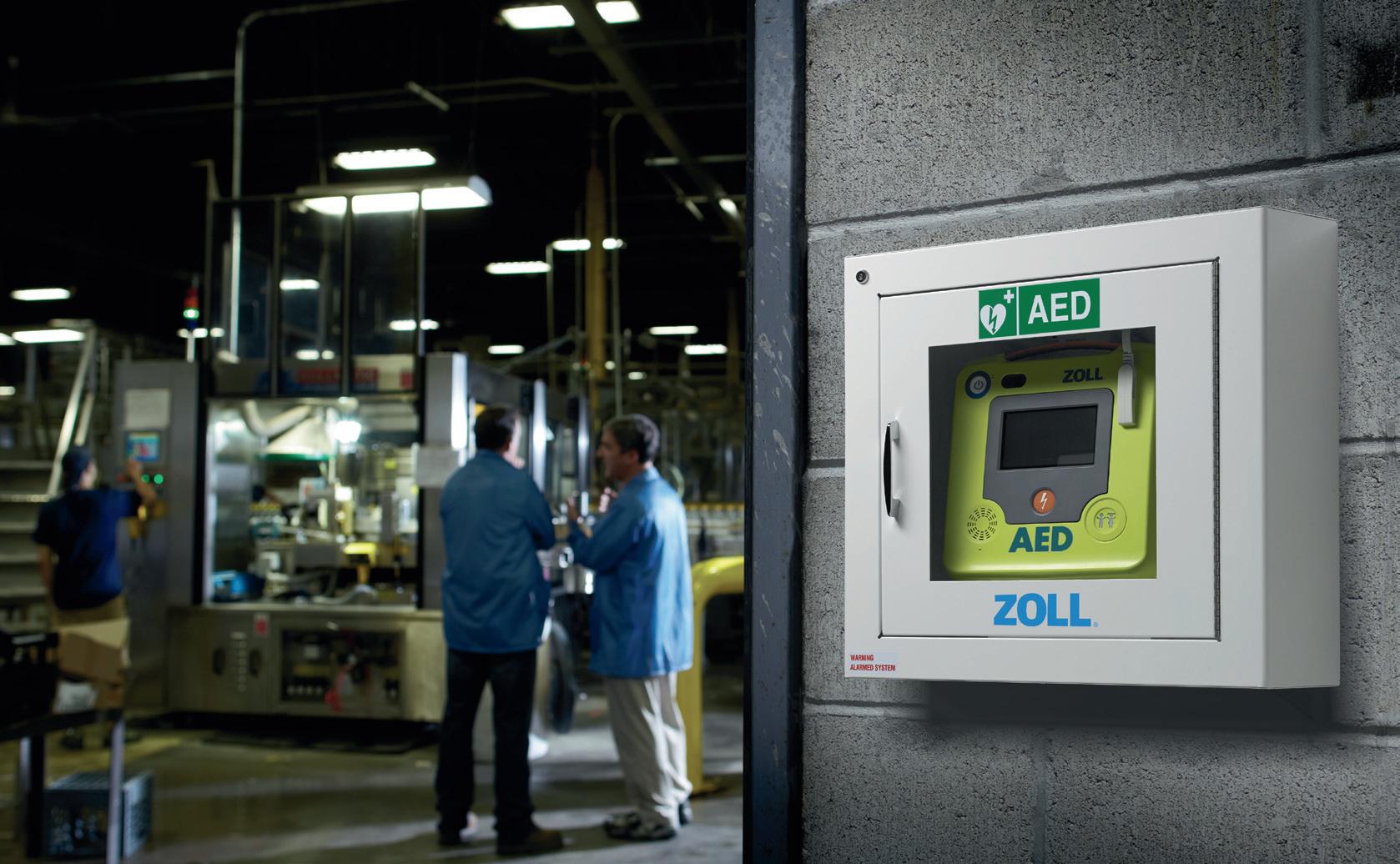
17 minute read
The rise of the cordless machines — safety benefits of a new generation of tools
THE RISE OF THE CORDLESS MACHINES
SAFETY BENEFITS OF A NEW GENERATION OF TOOLS
Tony Cooper, Product Engineer & Asia-Pacific Marketing Manager, Enerpac

Conscious of their duty of care (and the awful cost of injuries and shutdowns), companies in industries with high safety priorities — such as mining and energy, construction and infrastructure — are embracing a whole new generation of powerful, portable and ergonomic tools that lighten the load while they increase the safety and efficiency of operations such as bolting and unbolting, cutting, bending, lifting and forming.
©stock.adobe.com/au/HENADZY The huge surge in new infrastructure development in Australasia — coupled with a rising wave of decommissionings and conversions of obsolete fossil fuel plant — will present an array of safety challenges and opportunities for industry in the years ahead. Old manual methods of infrastructure construction and renewal will be replaced by new ways of exerting maximum force with minimal risk to workers, as we gratefully leave the age of flogging spanners and wasteful and unnecessary practices.
Hydraulic battery technology
Hydraulic battery technology has reached a point where cordless alternatives (such as hydraulic pumps) can now offer the same performance as their corded counterparts, with a sufficient fuel reservoir to last whole shifts without needing to replace or recharge the battery. An additional bonus is that they can be used in locations where there’s limited or no access to power, such as remote sites, inaccessible machinery or high places where dragging a cord around is not an option. Not to mention obviating the risk of electrocution.
In saying this, I should emphasise that for a myriad of applications, a corded tool is totally safe, and the ideal solution where the cords and power input are completely out of anyone’s way. And it should be emphasised too that both corded and cordless hydraulic tools available now are pursuing a path towards lighter weight and far better
Case study: mining equipment company lifts the lid on common conveyor belt problem
Mining equipment company Techmine Solutions developed a solution to a common mining problem — efficiently lifting thousands of metres of conveyor belts for maintenance. Techmine developed a lightweight hydraulic belt lifter that utilises Enerpac’s XC-Series Cordless Portable Hydraulic Pump to safely and reliably provide the hydraulic pressure (700 bar, 10,000 PSI) required to lift belt sections up to 2000 kg.
“The new belt lifter effortlessly raises the belt in 20 to 25 seconds without requiring complex input from the user,” said Justen Wright, Principal Engineer, Techmine, and inventor of the technology. “An 1800 mm belt lifter, comprised of three main parts, weighs only 29.5 kg once assembled. The main 13.7 kg lifting beam is ergonomic and easily portable.”

ergonomics and safety than ever before. This is particularly the case where the hydraulic technology is high-pressure (700 bar, 10,000 psi), which concentrates the greatest amount of force into the most compact and therefore easily handled tools. And for all clean, green electric tools — corded and cordless — increased safety is critical because of the huge personal and national costs of workplace accidents.
The toll on workers and businesses
A worker is killed at work nearly every second day in Australia, and as tragic as these deaths are, these figures represent just the tip of an accident iceberg. According to Safe Work Australia (SWA), work-related injuries cost the Australian economy around $60 billion every year, representing almost 5% of the nation’s GDP. Workplace injuries impose a terrific physical and mental toll on victims and their families. Injuries also prove to be a massive drain on businesses’ costs and productivity, with stoppages and remediation always involving downtime and punishing the uptime and efficiencies industries are seeking in these competitive times.
The industries on which I will focus this article — agriculture, transport, mining, construction, energy, manufacturing — make up the top six hazardous categories (which, in fairness, reflects the fact that these are also huge industries and big employers that have made many and continuing strides to minimise accidents). Common injuries and tools that can help The most common injuries across all industries, according to SWA, include sprains and strains of joints and muscles, which comprise 41.8% of all incidents. These are most often caused by poor manual handling practices and improper work health and safety handling, which can lead to the ubiquitous slip and trip accidents, among others. Workers who are required to bend and move their bodies to lift, carry or push heavy items are at serious risk of straining their muscles.
Following are some of the most common hazardous situations we seek solutions for by involving ergonomic, portable and cordless tools, or new technologies that replace manual inputs with time-saving and safer alternatives: 1. Slip and fall accidents, which are still too common to all sectors. 2. Repetitive strain injuries, in all industries, particularly where old equipment is manual and bulky. 3. Maintenance in confined spaces — especially mining energy and construction, but also inside heavy machinery (mobile and static). 4. Heavy lifting. 5. Emergency repairs in the field, to prevent downtime. 6. Rescue work, where powerful tools are needed immediately. 7. Airborne and remote sites work, where tools must be light and self-sufficient. 8. Sites where there is heavy wheeled traffic, such as forklifts in a factory or vehicles in a distribution centre. 9. Working at heights, particularly construction, but in plenty of other situations also, including mining loader booms, cranes and conveyors.
Of course, having the appropriate safety training to ensure standards compliance, and the safety of everyone involved is vital, whatever solution is adopted.
Bolting at height Carrying out bolting operations at height runs the risks of slip and fall accidents and the danger of dropped objects to those working beneath. Falls from height or being hit with moving or falling objects are among the major causes of death, and the cause of thousands of serious injuries to workers on construction and infrastructure projects. Such hazards will also become a greater challenge in the energy industry as wind towers become more and more prevalent.
Lightweight ergonomic cordless tools — properly secured, with proper training — help provide a solution by which workers can safely exert precise force on repetitive tasks such as bolting. Such lightweight tools will also provide a solution to fatigue when working in confined spaces, where there is limited room to manoeuvre around the workpiece and where manual labour can be hot and rapidly fatiguing.
Another area where cordless tools are making safety inroads is in the servicing of cranes and conveyors, without which industry ultimately cannot function. Heavy lifting Heavy lifting always presents challenges, both during the process — and sometimes further down the line, when unbalanced lifting can permanently compromise the long-term safety and stability of the structure being created. This is another area where technology is overtaking old methods, whether the lift involves, say, a single turbine or transformer, or an entire oil production platform, which must be precisely assembled, lifted, shifted and loaded so it can withstand the long-term effects of exposure to the elements at sea.
For example, high-efficiency, highsafety synchronous lifting technology,
OLD MANUAL METHODS OF INFRASTRUCTURE CONSTRUCTION AND
RENEWAL WILL BE REPLACED BY NEW WAYS OF EXERTING MAXIMUM
FORCE WITH MINIMAL RISK TO WORKERS, AS WE GRATEFULLY LEAVE THE AGE OF FLOGGING SPANNERS AND WASTEFUL AND
UNNECESSARY PRACTICES.
where required, can allow multiple cylinders to be used simultaneously to lift structures within an average accuracy between the cylinders of a millimetre or less. This technology can also weigh and balance the load, during lifting and shifting, to ensure safety and longevity of the structure.
One of the biggest jobs using this technology in recent years was where Malaysia Marine and Heavy Engineering used 352 compact, high-pressure 300-tonne cylinders to lift and skid the 43,000-tonne Gumusut-Kakap floating oil production system onto a vessel waiting in the Straits of Johor. While the technology employed is capable of lifting and shifting far greater weights than the Gumusut-Kakap (it can lift more than the equivalent of the 52,000-tonne weight of the steel in the Sydney Harbour Bridge, for example, or reposition a tunnel boring machine) it was the system’s ability to sense and control any deflection of the pontoons and main superstructure that won it plaudits for protecting structural integrity throughout the lift-weigh-shiftand-launch process.
The same synchronous lifting technology enabled contractor partners SKF and Sandvik to achieve precision, safety and avoidance of downtime during a 220-ton lift to facilitate slew bearing replacement on a GrainCorp ship loader at the Gladstone Port Terminal in Queensland. The EVO synchronous lifting system — using PLC control to manage four heavy-duty CLRG cylinders simultaneously — was used to lift the upper structure of the ship loader more than 300 mm, allowing the old bearing to be taken out and a new one put in.
When taking the slew bearing out of the Port of Gladstone loader, the upper
The 43,000-tonne GumusutKakap floating oil production system loads onto a vessel.

Case study: Queensland contracting company eases handling by saying farewell to flogging hammers
My final example of practical, shop floor enterprise and innovation (which is often where good safety practice comes into effect) comes from a Queensland contracting company. Gibson Instrumentation Services (GIS) developed a safer, faster and more cost-efficient way to assemble heavy ABON coal feeder chain links by replacing strenuous manual labour with compact and powerful hydraulic power.
The 700 bar high-pressure hydraulic equipment — supplied by Cooper Fluid Systems in Mackay — is used to assemble the chain links to form ABON conveyors of a type produced by FLSmidth for extensive use in the mining and energy, coal, cement and aggregate industries.
GIS eliminated the need to use flogging tools during on-site assembly by introducing into their workshop a neatly portable combination comprising Enerpac’s C-clamp, 10-ton cylinder and lightweight PU series Electric Economy Pump with pendant control and pressure gauge for safety.
The new combination is used in ABON OEM work in the workshop to precisely assemble chain lengths often weighing more than a ton, typically achieving tasks in one day that previously might have taken several. The combination weighs less than half the 37 kg of the previous customised tool that took two people to lift safely and required a crane for positioning. The new tool is also light enough to be taken onsite for maintenance tasks, where it also increases the safety of the job and cuts the time taken to do it.
High-tonnage cylinders linked to an EVO system help lift the slew bearing for SKF and Sandvik in Gladstone. structure needed to be lifted straight up with absolute precision. The EVO system managed to stay within an average accuracy between the cylinders of 0.54 mm, which is incredibly accurate for a lift like this. Using the EVO synchronous lifting system allows companies like SKF and Sandvik to lift all sides of the bearing evenly and precisely from a central control point. By digitally monitoring and controlling lifting operations, they can enhance safety and precision compared with manual lifting operations.

The time for cordless machines is now
Recent worldwide events have forced a rethink of the old ways of doing things. During the coronavirus (COVID-19) pandemic, for example, we have all been forced to look at new ways of performing old tasks. Because we couldn’t have too many people together, there has been a spurt in the relevance of digital technologies (such as the EVO synchronous lifting technology). Technologies that enable us to do a better job, while removed from danger, are getting a real boost. At the same time, the automotive transformation from fossil fuels to electric power has taken giant strides.
Over the last decade a surge in lithiumion battery production has led to an 85% decline in prices, making electric vehicles and energy storage commercially viable for the first time in history. Battery-based safety tools have benefited immensely. Once not regarded as a serious heavy-duty tool, they are now coming into their own as a mainstream safety product, benefiting both the environment generally and their users particularly. Sometimes, it seems, it takes a major problem to produce a major advance. Let’s make this the case for safety in the workplace, which is a concern we all share.
Enerpac www.enerpac.com.au








Quality ISO 9001
CASE
STUDY Advanced defibrillators win five-star safety award

Earlier this year, ZOLL Medical Corporation, a company that manufactures medical devices and related software solutions, was recognised by the World of Safety & Health Asia (WSHAsia) in its inaugural New & Innovative Solutions Awards program. ZOLL was recognised for its ZOLL AED 3 and ZOLL AED 3 BLS automated external defibrillators (AEDs); as the only products to receive a five-star rating, the defibrillators were recognised for their smart technology and short interval between compressions and shock delivery.
Elijah A White, President of ZOLL Resuscitation, said the company is committed to delivering live-saving AEDs that enable bystanders and rescuers to act quickly and with confidence in medical emergencies. “We’re honoured to be recognised by World of Safety & Health Asia for our Real CPR Help and RapidShock technologies. Research shows that real-time CPR feedback, along with training, more than doubles cardiac arrest survival rates, and we’re dedicated to doing our part to deliver advanced CPR feedback technology, ease of use and reliability to support both professional and lay rescuers through each step of the process,” said White.
The New & Innovative Solution Awards recognise excellence in products and services that aim to improve workplace safety and health. A panel of five renowned figures in the safety and health industry from across the Asia–Pacific region evaluated the entries, with a five-star rating indicating approval from each of the five judges. The ZOLL AED 3 and AED 3 BLS defibrillators both include ZOLL’s RapidShock Analysis technology, with short pauses for analysis and fast time to shock. It can analyse a patient’s heart rhythm in three seconds, followed by delivery of the shock in as little as five seconds.
The intuitive design and enhanced features of the ZOLL AED 3 defibrillator give users the confidence and knowledge needed to treat sudden cardiac arrest (SCA). Real CPR Help technology helps rescuers deliver high-quality CPR with real-time, guideline-driven feedback on the quality of chest compressions. The ZOLL AED 3 also features full-colour display with vivid rescue images, a CPR cycle timer and a large colour bar gauge that shows CPR compression depth. The universal design of the CPR Uni-padz electrodes on the ZOLL AED 3 allows rescuers to treat adult and paediatric victims of SCA with the same set of pads by activating the child mode. Wi-Fi connectivityenables automatic reporting of device status, enabling organisations and rescuers to know the AED is ready for use. It also provides the ability to access and transmit cardiac arrest event data to medical professionals.
The ZOLL AED 3 BLS defibrillator includes all the features of the ZOLL AED 3 defibrillator, but also provides in-depth rescue support for professional rescuers. A CPR dashboard on the device shows elapsed time, CPR cycle countdown, shocks delivered and ECD. RescueNet CaseReview enables rescue performance data to be exported via USB or transferred directly over Wi-Fi. Data can be evaluated and used to improve future responder performance. The ZOLL AED 3 BLS guides rescuers in delivering high-quality CPR and is designed to be one of the fastest AEDs in the industry at delivering a shock after chest compressions stop — two critical components to increasing a victim’s chance of survival.
Raymond Watt, founder of World of Safety & Health Asia, said the ZOLL AED 3 and ZOLL AED 3 BLS were designed with smart technologies that support all rescuers and automated monitoring features with Wi-Fi connectivity to enhance emergency readiness. “We are impressed by the innovative AEDs from ZOLL Medical, with their remarkably short pre-shock pauses between compression cycles: the shortest in the industry,” said Watt ZOLL Medical Australia www.zoll.com.au

Lone worker safety app

WorkSafe Guardian is a lone worker safety system that provides an on-demand monitored alert response to employees, relieving management of their responsibility to be available 24/7. It can be utilised in all industries for field staff, isolated workers, in-home services or working from home.
WorkSafe Guardian allows employees to activate either a medical alert or a safety alert; these alerts are responded to with the appropriate emergency personnel and can be activated in four different ways. All alerts are actioned by licensed and trained professionals at the WSG Response Centre. The Response Centre is approved by all relevant emergency services around Australia and is accredited ASIAL ‘Grade A1’ — the highest possible rating under the Australian Standards.
A secure online portal enables management to issue staff the WSG App to utilise welfare check-ins, safety and medical alerts with location tracking only when assistance is required. WSG supports organisations to reduce risk and perform their duty of care to employees working alone. Managing the WorkSafe Guardian app is made easy with a user-friendly interface and easy onboarding. Whether users need to add new employees, set escalation groups for response plans or generate user reports, WSG is designed for people with any technology background and is included for unlimited users with no additional charges.
WorkSafe Guardian
www.worksafeguardian.com.au

Health and safety management software
Safety Champion software is a smart health and safety management software that supports hundreds of Australian businesses across various industries to boost their safety performance. It is developed by UI/UX focused software designers and developers and OHS/WHS consultants to deliver sustainable and effective safety programs over time.
With a clean and simple interface, powerful reporting, intuitive dashboard, userfriendly iOS/Android Apps and preloaded templates, Safety Champion software enables businesses to meet their legislative and compliance duties. The software includes 13 essential modules for effective safety management, including incident reporting, planning and compliance, inspections and audit, hazard and corrective action, communication and induction, site attendance, reporting, document, insurance, chemical, training, contractor and human resource.
Safety Champion’s experienced OHS/WHS professionals guide businesses throughout the implementation process, tailoring their approach to help software work for unique business needs.
Safety Champion Software Pty Ltd
www.safetychampion.com.au
Machinery safety platform
Plant Assessor is a cloud-based machinery compliance and risk assessment software that is dedicated to ensuring machinery is safe for use and meets all legal compliance requirements. Plant Assessor captures and facilitates the sharing of machinery information between principal contractors, subcontractors, hire companies and more. Containing details of over 110,000 makes and models of equipment, Plant Assessor is a large machinery safety platform with a safety solution to meet the needs of anyone who owns, operates, manages or supplies plant.
With Plant Assessor, users can perform the following tasks easily and efficiently: machinery risk assessments, digital pre-start safety checks, set up machine service and scheduling alerts, access machine-specific safety and risk assessment information in real time, and outsource risk assessments to Plant Assessor’s Professional Services team.
Plant Assessor can reduce safety management costs, increase safety management effectiveness and productivity, and help users feel confident in their machinery safety systems and processes. Users can stay up to date with the latest industry developments and legislations, and gain access to machinery compliance safety experts.
Plant Assessor
www.assessor.com.au








